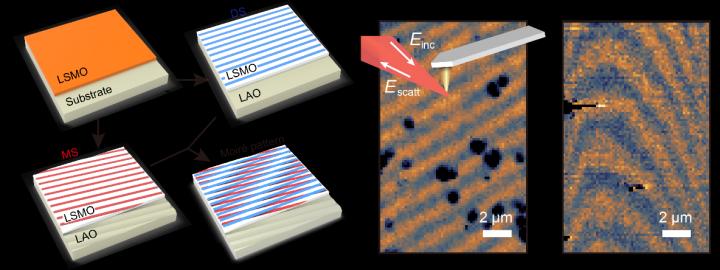
Credit: FAN Xiaodong, LI Lin and CHEN Xin
The research team of Prof. ZENG Changgan from Hefei National Laboratory for Physical Sciences at the Microscale of University of Sciences and Technology of China (USTC) of the Chinese Academy of Sciences (CAS), collaborating with Prof. LIU Mengkun from Stony Brook University, applied moiré engineering beyond van der Waals materials for the first time and realized moiré-type electronic modulations in correlated transition metal oxides (CTMOs) at mesoscale. The result was published online on Nature Physics on April 6th.
In van der Waals heterostructures, moiré patterns can be achieved by stacking two-dimensional atomic layers with slightly incommensurate periodicities or small twist angles. Fascinating properties have emerged in these moiré systems, including topological conducting channels in twisted bilayer graphene. Application of moiré modulation beyond two dimensional van der Waals system may reveal many other novel properties, however, it remains a daunting task for researchers.
In this study, the prominent property of spontaneous spatially electronic textures in prototypical CTMO, La0.67Sr0.33MnO3 (LSMO), allowed the researchers to exercise periodic strain modulation.
By growing epitaxial LSMO films on LaAlO3 (LAO) substrates, in the system there existed two different periodic strain modulations with small spacing: domain stripes (DSs) resulted from local relaxations of substrate-imposed shear strain, and miscut stripes (MSs) stemmed from surface miscut steps in the LAO substrate. Observations under scanning near-field optical microscopy (SNOM) validated moiré landscapes generated by the spatial coexistence of DS and MS with a periodicity considerably larger than that of either DSs or MSs and able to be governed by the orientations of these stripe motifs.
Using this method, more complex patterns, such as curved moiré fringes can also be presented. Non-linear relationship between the strain and the conductivity has made the modulation easily constructed.
Conductivity and ferromagnetism are intimately tied in LSMO. Further observations under magnetic force microscopy (MFM) measurements revealed moiré conductivity fringes and moiré modulations of local ferromagnetism, thus the second-order transition, from ferromagnetic metal to paramagnetic metal occurred at Curie point (TC), provided another mechanism of electronic texture modulation. Below TC, these two fringes coexisted, while above TC, magnetic moiré fringes disappeared and only the electronic counterpart persisted.
This study realized moiré engineering beyond van der Waals materials for the first time, demonstrates the feasibility of producing and visualizing surface moiré patterns that yield optical contrast, and provides a potential and brand-new route to achieving spatially patterned electronic textures on demand in strained epitaxial materials.
###
Media Contact
Jane FAN Qiong
[email protected]
Original Source
http://english.
Related Journal Article
http://dx.





